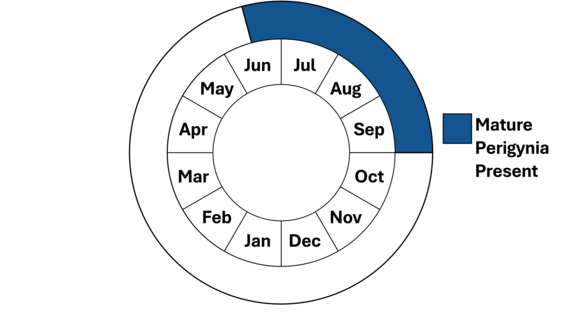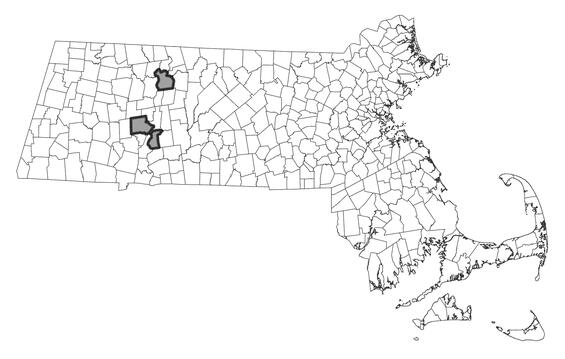- Scientific name: Carex squarrosa
- Species of Greatest Conservation Need (MA State Wildlife Action Plan)
- Threatened (MA Endangered Species Act)
Description
Squarrose sedge is a perennial, herbaceous, grass-like plant that grows in loose clumps up to 0.9 m (3 ft) in height. This species was recently rediscovered in Massachusetts. Squarrose sedge is typically found within riparian habitats that have alluvial soils. The uppermost spikes have pistillate (ovule-bearing) flowers borne above staminate (pollen-bearing) flowers. The large, dense, reproductive spikes of squarrose sedge make this species rather distinctive from other members of the genus Carex.
To positively identify the squarrose sedge and other members of the genus Carex, a technical manual should be consulted. Species in this genus have small unisexual wind-pollinated flowers that are borne in clusters or spikes. Each flower is unisexual, and is closely subtended by small, flat scales. The staminate flowers are subtended by a single flat scale (the staminate scale); the pistillate flowers are subtended by one flat scale (the pistillate scale) and are enclosed by a second sac-like modified scale, the perigynium (plural: perigynia). After flowering, the achene (a dry, one-seeded fruit) develops within the perigynium. The morphological characteristics of these reproductive structures are important in identifying plants of the genus Carex.
Squarrose sedge is a large sedge that grows in tufts from short rhizomes. Its stout, leafy stems range in height from 0.3-0.9 m (1-3 ft). The elongate leaves are 3-6 mm (1/8- ¼ in) in width. Reproductive stems (culms) produce one to three dense spikes that are ovoid to elliptic and rounded at both ends. The terminal spike has a short, narrow bract and staminate flowers are flattened against the stem below the ovoid cluster of perigynia. The lateral spike(s), when present, are upright, smaller than the terminal spike, and have long leaf-like bracts. The achenes are 1.1 to 1.4 mm (0.04-0.06 in) wide with a persistent, strongly sinuous style.
Squarrose sedge is closely related to and might be confused with the state-listed cat-tail sedge, Carex typhina (threatened). Both species have spikes with densely crowded perigynia above the staminate florets and the floral scales are not visible between the crowded perigynia. However, the spikes of cat-tail sedge form more elongate, cylindrical heads with truncate bases and few or no downward pointing perigynia. In addition, the styles of cat-tail sedge are straight and deciduous while those of squarrose sedge are sinuous and persistent.
Life cycle and behavior

Species in this genus have small unisexual wind-pollinated flowers that are borne in clusters or spikes. Each flower is unisexual, and is closely subtended by small, flat scales. The staminate flowers are subtended by a single flat scale (the staminate scale); the pistillate flowers are subtended by one flat scale (the pistillate scale) and are enclosed by a second sac-like modified scale, the perigynium (plural: perigynia). After flowering, the achene (a dry, one-seeded fruit) develops within the perigynium.
Population status
Squarrose sedge is listed as threatened under the Massachusetts Endangered Species Act. There are 4 populations in the state that have been verified since 1999. It is possible that additional populations will be found in the state.
Distribution and abundance
Massachusetts is at the northeastern extent of the range for squarrose sedge. It occurs south to Louisiana, west to Nebraska, and north to Ontario. In the northeast, squarrose sedge is not protected in New York, but listed as special concern in Connecticut and state historic in Rhode Island. It is not known from Maine, New Hampshire, or Vermont.

Distribution in Massachusetts
1999-2024
Based on records in the Natural Heritage Database
Habitat
Squarrose sedge in Massachusetts has been found in association with small-river floodplain forests in two locations, and in a new cut for a powerline in the third location. All locations are considered wetlands, though the soil may not be saturated all year. Plant species that might be found in association with squarrose sedge include silver maple (Acer saccharinum), swamp milkweed (Asclepias incarnata), monkey-flower (Mimulus ringens), sensitive fern (Onoclea sensibilis), and poison ivy (Toxicodendron radicans), as well as other state listed species: Gray’s sedge (Carex grayi, Threatened), cat-tail sedge (Carex typhina, Threatened) and green dragon (Arisaema dracontium, Threatened).
Healthy habitats are vital for supporting native wildlife and plants. Explore habitats and learn about conservation and restoration in Massachusetts.
Threats
The exact needs for this species are not known, but competition from non-native invasive species is likely to be a threat. Destruction of habitat is a threat for all rare species. Changes in hydrology and in the water quality may also pose a threat to this species; this is particularly true as floodwaters are likely to be an important seed dispersal mechanism for this species.
Conservation
Monitoring and removal of competing vegetation should be considered as a management strategy where appropriate. All active management of rare plant populations (including invasive species control or removal) is subject to review under the Massachusetts Endangered Species Act and should be planned in close consultation with MassWildlife’s Natural Heritage and Endangered Species Program. All listed species are protected from killing, collecting, possessing, or sale and from activities that would destroy habitat and thus directly or indirectly cause mortality or disrupt critical behaviors.
References
Ford, B. A., and A.A. Reznicek. 2002. Section 26uu. Linnaeus sect. SQUARROSAE J. Carey, Carices North. In Flora of North America Editorial Committee. 2002. Flora of North America, North of Mexico. Volume 23 Magnoliophyta: Commelinidae (in part): Cyperaceae. Oxford University Press. New York. pp. 519.
Gleason, H. A., and Arthur Cronquist. 1991. Manual of Vascular Plants of Northeastern United States and Adjacent Canada, Second Edition. The New York Botanical Garden, New York.
Haines, A. 2011. Flora Novae Angliae. New England Wild Flower Society. Yale University Press, New Haven and London.
Contact
| Date published: | April 9, 2025 |
|---|